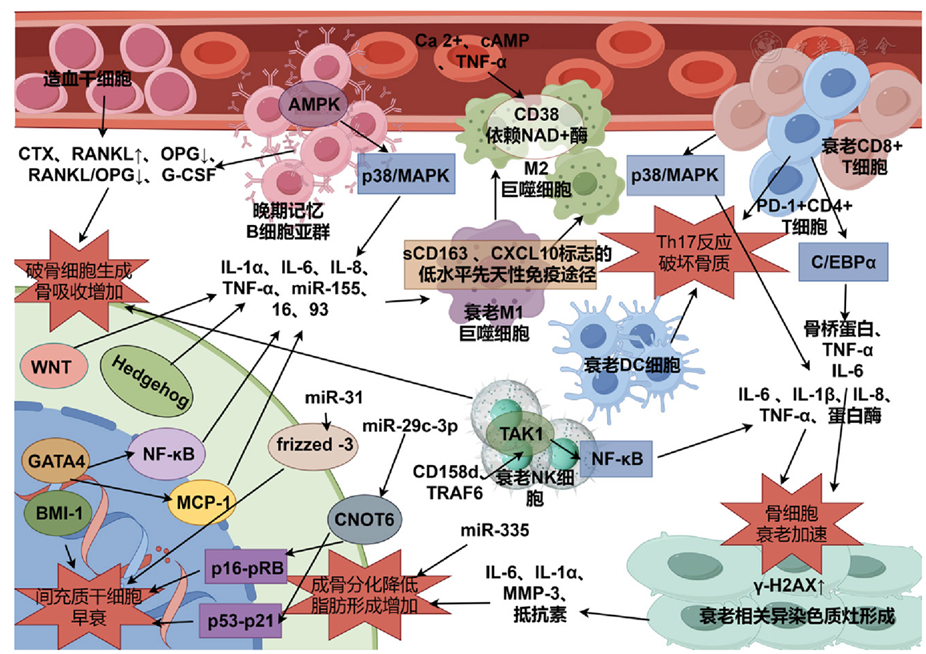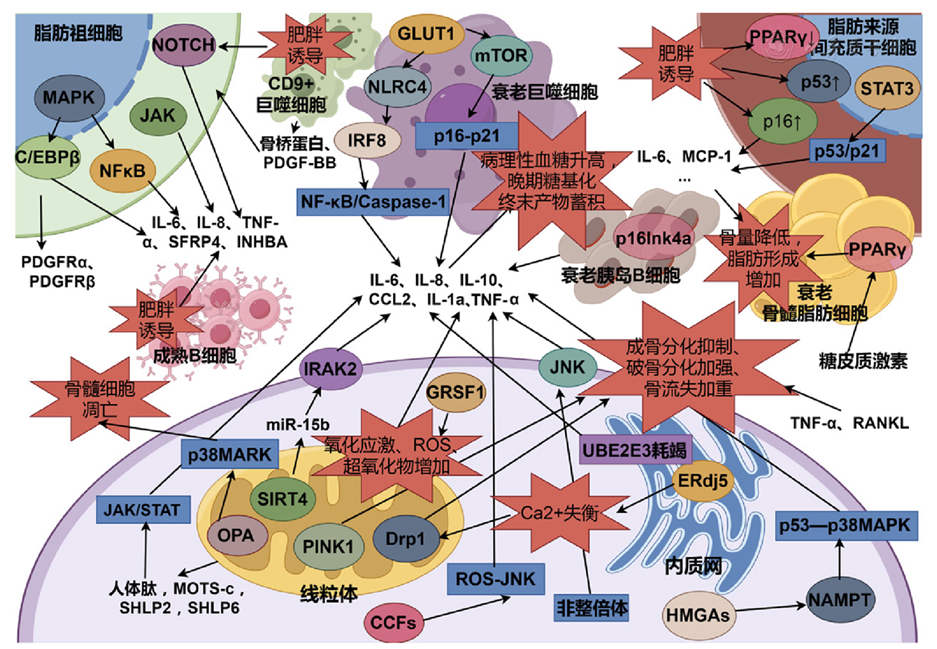| [1] |
WANG L H, YU W, YIN X J,et al. Prevalence of osteoporosis and fracture in China:the China osteoporosis prevalence study[J]. JAMA Netw Open, 2021, 4(8):e2121106. DOI: 10.1001/jamanetworkopen.2021.21106.
|
| [2] |
CONTI V, RUSSOMANNO G, CORBI G,et al. A polymorphism at the translation start site of the vitamin D receptor gene is associated with the response to anti-osteoporotic therapy in postmenopausal women from southern Italy[J]. Int J Mol Sci, 2015, 16(3):5452-5466. DOI: 10.3390/ijms16035452.
|
| [3] |
COPPÉ J P, PATIL C K, RODIER F,et al. Senescence-associated secretory phenotypes reveal cell-nonautonomous functions of oncogenic RAS and the p53 tumor suppressor[J]. PLoS Biol, 2008, 6(12):2853-2868. DOI: 10.1371/journal.pbio.0060301.
|
| [4] |
ZHAO R L, JIN X Y, LI A,et al. Precise diabetic wound therapy:PLS nanospheres eliminate senescent cells via DPP4 targeting and PARP1 activation[J]. Adv Sci, 2022, 9(1):e2104128. DOI: 10.1002/advs.202104128.
|
| [5] |
JIN W N, SHI K B, HE W Y,et al. Neuroblast senescence in the aged brain augments natural killer cell cytotoxicity leading to impaired neurogenesis and cognition[J]. Nat Neurosci, 2021, 24(1):61-73. DOI: 10.1038/s41593-020-00745-w.
|
| [6] |
HU L F, YIN C, ZHAO F,et al. Mesenchymal stem cells:cell fate decision to osteoblast or adipocyte and application in osteoporosis treatment[J]. Int J Mol Sci, 2018, 19(2):360. DOI: 10.3390/ijms19020360.
|
| [7] |
DING P, GAO C, GAO Y S,et al. Osteocytes regulate senescence of bone and bone marrow[J]. eLife, 2022, 11:e81480. DOI: 10.7554/eLife.81480.
|
| [8] |
SINHA S, SINHA A, DONGRE P,et al. Organelle dysfunction upon asrij depletion causes aging-like changes in mouse hematopoietic stem cells[J]. Aging Cell, 2022, 21(4):e13570. DOI: 10.1111/acel.13570.
|
| [9] |
TRESGUERRES F G F, TORRES J, LÓPEZ-QUILES J,et al. The osteocyte:a multifunctional cell within the bone[J]. Ann Anat, 2020, 227:151422. DOI: 10.1016/j.aanat.2019.151422.
|
| [10] |
BLOCK T J, MARINKOVIC M, TRAN O N,et al. Restoring the quantity and quality of elderly human mesenchymal stem cells for autologous cell-based therapies[J]. Stem Cell Res Ther, 2017, 8(1):239. DOI: 10.1186/s13287-017-0688-x.
|
| [11] |
ZHUANG Y, LI D, FU J Q,et al. Comparison of biological properties of umbilical cord-derived mesenchymal stem cells from early and late passages:immunomodulatory ability is enhanced in aged cells[J]. Mol Med Rep, 2015, 11(1):166-174. DOI: 10.3892/mmr.2014.2755.
|
| [12] |
WANG L P, ZHANG H, XIAO X,et al. Small extracellular vesicles maintain homeostasis of senescent mesenchymal stem cells at least through excreting harmful lipids[J]. Stem Cells Dev, 2023, 32(17/18):565-579. DOI: 10.1089/scd.2023.0079.
|
| [13] |
KIM M, BAE Y K, UM S,et al. A small-sized population of human umbilical cord blood-derived mesenchymal stem cells shows high stemness properties and therapeutic benefit[J]. Stem Cells Int, 2020, 2020:5924983. DOI: 10.1155/2020/5924983.
|
| [14] |
LUNYAK V V, AMARO-ORTIZ A, GAUR M. Mesenchymal stem cells secretory responses:senescence messaging secretome and immunomodulation perspective[J]. Front Genet, 2017, 8:220. DOI: 10.3389/fgene.2017.00220.
|
| [15] |
KWON J H, KIM M, UM S,et al. Senescence-associated secretory phenotype suppression mediated by small-sized mesenchymal stem cells delays cellular senescence through TLR2 and TLR5 signaling[J]. Cells, 2021, 10(1):63. DOI: 10.3390/cells10010063.
|
| [16] |
CHOU L Y, HO C T, HUNG S C. Paracrine senescence of mesenchymal stromal cells involves inflammatory cytokines and the NF-κB pathway[J]. Cells, 2022, 11(20):3324. DOI: 10.3390/cells11203324.
|
| [17] |
LEHMANN J, NARCISI R, FRANCESCHINI N,et al. WNT/beta-catenin signalling interrupts a senescence-induction cascade in human mesenchymal stem cells that restricts their expansion[J]. Cell Mol Life Sci, 2022, 79(2):82. DOI: 10.1007/s00018-021-04035-x.
|
| [18] |
VOSKAMP C, ANDERSON L A, KOEVOET W J,et al. TWIST1 controls cellular senescence and energy metabolism in mesenchymal stem cells[J]. Eur Cell Mater, 2021, 42:401-414. DOI: 10.22203/eCM.v042a25.
|
| [19] |
LEE J Y, YU K R, LEE B C,et al. GATA4-dependent regulation of the secretory phenotype via MCP-1 underlies lamin A-mediated human mesenchymal stem cell aging[J]. Exp Mol Med, 2018, 50(5):1-12. DOI: 10.1038/s12276-018-0092-3.
|
| [20] |
ZHENG X L, WANG Q X, XIE Z,et al. The elevated level of IL-1α in the bone marrow of aged mice leads to MSC senescence partly by down-regulating Bmi-1[J]. Exp Gerontol, 2021, 148:111313. DOI: 10.1016/j.exger.2021.111313.
|
| [21] |
SHANG J, YAO Y, FAN X,et al. MiR-29c-3p promotes senescence of human mesenchymal stem cells by targeting CNOT6 through p53-p21 and p16-pRB pathways[J]. Biochim Biophys Acta, 2016, 1863(4):520-532. DOI: 10.1016/j.bbamcr.2016.01.005.
|
| [22] |
WEILNER S, SCHRAML E, WIESER M,et al. Secreted microvesicular miR-31 inhibits osteogenic differentiation of mesenchymal stem cells[J]. Aging Cell, 2016, 15(4):744-754. DOI: 10.1111/acel.12484.
|
| [23] |
TOMÉ M, SEPÚLVEDA J C, DELGADO M,et al. MiR-335 correlates with senescence/aging in human mesenchymal stem cells and inhibits their therapeutic actions through inhibition of AP-1 activity[J]. Stem Cells, 2014, 32(8):2229-2244. DOI: 10.1002/stem.1699.
|
| [24] |
MATO-BASALO R, MORENTE-LÓPEZ M, ARNTZ O J,et al. Therapeutic potential for regulation of the nuclear factor kappa-B transcription factor p65 to prevent cellular senescence and activation of pro-inflammatory in mesenchymal stem cells[J]. Int J Mol Sci, 2021, 22(7):3367. DOI: 10.3390/ijms22073367.
|
| [25] |
SORIANI A, IANNITTO M L, RICCI B,et al. Reactive oxygen species- and DNA damage response-dependent NK cell activating ligand upregulation occurs at transcriptional levels and requires the transcriptional factor E2F1[J]. J Immunol, 2014, 193(2):950-960. DOI: 10.4049/jimmunol.1400271.
|
| [26] |
SHARMA C, WANG H X, LI Q L,et al. Protein acyltransferase DHHC3 regulates breast tumor growth,oxidative stress,and senescence[J]. Cancer Res, 2017, 77(24):6880-6890. DOI: 10.1158/0008-5472.CAN-17-1536.
|
| [27] |
LEFÈVRE L, IACOVONI J S, MARTINI H,et al. Kidney inflammaging is promoted by CCR2+ macrophages and tissue-derived micro-environmental factors[J]. Cell Mol Life Sci, 2021, 78(7):3485-3501. DOI: 10.1007/s00018-020-03719-0.
|
| [28] |
FUJIU K, MANABE I, NAGAI R. Renal collecting duct epithelial cells regulate inflammation in tubulointerstitial damage in mice[J]. J Clin Investig, 2011, 121(9):3425-3441. DOI: 10.1172/JCI57582.
|
| [29] |
HEARPS A C, MARTIN G E, ANGELOVICH T A,et al. Aging is associated with chronic innate immune activation and dysregulation of monocyte phenotype and function[J]. Aging Cell, 2012, 11(5):867-875. DOI: 10.1111/j.1474-9726.2012.00851.x.
|
| [30] |
ZHANG B, BAILEY W M, BRAUN K J,et al. Age decreases macrophage IL-10 expression:implications for functional recovery and tissue repair in spinal cord injury[J]. Exp Neurol, 2015, 273:83-91. DOI: 10.1016/j.expneurol.2015.08.001.
|
| [31] |
HOLT D J, GRAINGER D W. Senescence and quiescence induced compromised function in cultured macrophages[J]. Biomaterials, 2012, 33(30):7497-7507. DOI: 10.1016/j.biomaterials.2012.06.099.
|
| [32] |
BOADA-ROMERO E, MARTINEZ J, HECKMANN B L,et al. The clearance of dead cells by efferocytosis[J]. Nat Rev Mol Cell Biol, 2020, 21(7):398-414. DOI: 10.1038/s41580-020-0232-1.
|
| [33] |
DORAN A C, YURDAGUL A Jr, TABAS I. Efferocytosis in health and disease[J]. Nat Rev Immunol, 2020, 20(4):254-267. DOI: 10.1038/s41577-019-0240-6.
|
| [34] |
MORIOKA S, MAUERÖDER C, RAVICHANDRAN K S. Living on the edge:efferocytosis at the interface of homeostasis and pathology[J]. Immunity, 2019, 50(5):1149-1162. DOI: 10.1016/j.immuni.2019.04.018.
|
| [35] |
SCHLOESSER D, LINDENTHAL L, SAUER J,et al. Senescent cells suppress macrophage-mediated corpse removal via upregulation of the CD47-QPCT/L axis[J]. J Cell Biol, 2023, 222(2):e202207097. DOI: 10.1083/jcb.202207097.
|
| [36] |
ORECCHIONI M, GHOSHEH Y, PRAMOD A B,et al. Macrophage polarization:different gene signatures in M1(LPS+) vs. classically and M2(LPS-) vs. alternatively activated macrophages[J]. Front Immunol, 2019, 10:1084. DOI: 10.3389/fimmu.2019.01084.
|
| [37] |
MONTANARO M, MELONI M, ANEMONA L,et al. Macrophage activation and M2 polarization in wound bed of diabetic patients treated by dermal/epidermal substitute nevelia[J]. Int J Low Extrem Wounds, 2022, 21(4):377-383. DOI: 10.1177/1534734620945559.
|
| [38] |
TAMAKI S, KUROSHIMA S, HAYANO H,et al. Dynamic polarization shifting from M1 to M2 macrophages in reduced osteonecrosis of the jaw-like lesions by cessation of anti-RANKL antibody in mice[J]. Bone, 2020, 141:115560. DOI: 10.1016/j.bone.2020.115560.
|
| [39] |
KOHNO K, KOYA-MIYATA S, HARASHIMA A,et al. Inflammatory M1-like macrophages polarized by NK-4 undergo enhanced phenotypic switching to an anti-inflammatory M2-like phenotype upon co-culture with apoptotic cells[J]. J Inflamm, 2021, 18(1):2. DOI: 10.1186/s12950-020-00267-z.
|
| [40] |
DING L, YUAN X Y, YAN J H,et al. Nrf2 exerts mixed inflammation and glucose metabolism regulatory effects on murine RAW264.7 macrophages[J]. Int Immunopharmacol, 2019, 71:198-204. DOI: 10.1016/j.intimp.2019.03.023.
|
| [41] |
SPRANGERS S, DE VRIES T J, EVERTS V. Monocyte heterogeneity:consequences for monocyte-derived immune cells[J]. J Immunol Res, 2016, 2016:1475435. DOI: 10.1155/2016/1475435.
|
| [42] |
GEBRAAD A, KORNILOV R, KAUR S,et al. Monocyte-derived extracellular vesicles stimulate cytokinesecretion and gene expression of matrixmetalloproteinases by mesenchymal stem/stromal cells[J]. FEBS J, 2018, 285(12):2337-2359. DOI: 10.1111/febs.14485.
|
| [43] |
ONG S M, HADADI E, DANG T M,et al. The pro-inflammatory phenotype of the human non-classical monocyte subset is attributed to senescence[J]. Cell Death Dis, 2018, 9(3):266. DOI: 10.1038/s41419-018-0327-1.
|
| [44] |
PENCE B D, YARBRO J R, EMMONS R S. Growth differentiation factor-15 is associated with age-related monocyte dysfunction[J]. Aging Med, 2021, 4(1):47-52. DOI: 10.1002/agm2.12128.
|
| [45] |
TSUKASAKI M, KOMATSU N, NAGASHIMA K,et al. Host defense against oral microbiota by bone-damaging T cells[J]. Nat Commun, 2018, 9(1):701. DOI: 10.1038/s41467-018-03147-6.
|
| [46] |
GARLET G P, CARDOSO C R, MARIANO F S,et al. Regulatory T cells attenuate experimental periodontitis progression in mice[J]. J Clin Periodontol, 2010, 37(7):591-600. DOI: 10.1111/j.1600-051X.2010.01586.x.
|
| [47] |
KOMATSU N, TAKAYANAGI H. Immune-bone interplay in the structural damage in rheumatoid arthritis[J]. Clin Exp Immunol, 2018, 194(1):1-8. DOI: 10.1111/cei.13188.
|
| [48] |
JANG H M, PARK J Y, LEE Y J,et al. TLR2 and the NLRP3 inflammasome mediate IL-1β production in Prevotella nigrescens-infected dendritic cells[J]. Int J Med Sci, 2021, 18(2):432-440. DOI: 10.7150/ijms.47197.
|
| [49] |
ELSAYED R, ELASHIRY M, LIU Y T,et al. Porphyromonas gingivalis provokes exosome secretion and paracrine immune senescence in bystander dendritic cells[J]. Front Cell Infect Microbiol, 2021, 11:669989. DOI: 10.3389/fcimb.2021.669989.
|
| [50] |
SÖDERSTRÖM K, STEIN E, COLMENERO P,et al. Natural killer cells trigger osteoclastogenesis and bone destruction in arthritis[J]. Proc Natl Acad Sci U S A, 2010, 107(29):13028-13033. DOI: 10.1073/pnas.1000546107.
|
| [51] |
ZANG J F, YE J, ZHANG C,et al. Senescent hepatocytes enhance natural killer cell activity via the CXCL-10/CXCR3 axis[J]. Exp Ther Med, 2019, 18(5):3845-3852. DOI: 10.3892/etm.2019.8037.
|
| [52] |
RAJAGOPALAN S, LEE E C, DUPRIE M L,et al. TNFR-associated factor 6 and TGF-β-activated kinase 1 control signals for a senescence response by an endosomal NK cell receptor[J]. J Immunol, 2014, 192(2):714-721. DOI: 10.4049/jimmunol.1302384.
|
| [53] |
RAJAGOPALAN S, LONG E O. Cellular senescence induced by CD158d reprograms natural killer cells to promote vascular remodeling[J]. Proc Natl Acad Sci U S A, 2012, 109(50):20596-20601. DOI: 10.1073/pnas.1208248109.
|
| [54] |
DAR H Y, SINGH A, SHUKLA P,et al. High dietary salt intake correlates with modulated Th17-Treg cell balance resulting in enhanced bone loss and impaired bone-microarchitecture in male mice[J]. Sci Rep, 2018, 8(1):2503. DOI: 10.1038/s41598-018-20896-y.
|
| [55] |
DAR H Y, SHUKLA P, MISHRA P K,et al. Lactobacillus acidophilus inhibits bone loss and increases bone heterogeneity in osteoporotic mice via modulating Treg-Th17 cell balance[J]. Bone Rep, 2018, 8:46-56. DOI: 10.1016/j.bonr.2018.02.001.
|
| [56] |
SHASHKOVA E V, TRIVEDI J, CLINE-SMITH A B,et al. Osteoclast-primed Foxp3+ CD8 T cells induce T-bet,eomesodermin,and IFN-γ to regulate bone resorption[J]. J Immunol, 2016, 197(3):726-735. DOI: 10.4049/jimmunol.1600253.
|
| [57] |
FUKUSHIMA Y, MINATO N, HATTORI M. The impact of senescence-associated T cells on immunosenescence and age-related disorders[J]. Inflamm Regen, 2018, 38:24. DOI: 10.1186/s41232-018-0082-9.
|
| [58] |
CALLENDER L A, CARROLL E C, BEAL R W J,et al. Human CD8+ EMRA T cells display a senescence-associated secretory phenotype regulated by p38 MAPK[J]. Aging Cell, 2018, 17(1):e12675. DOI: 10.1111/acel.12675.
|
| [59] |
FRASCA D, DIAZ A, ROMERO M,et al. Human peripheral late/exhausted memory B cells express a senescent-associated secretory phenotype and preferentially utilize metabolic signaling pathways[J]. Exp Gerontol, 2017, 87(Pt A):113-120. DOI: 10.1016/j.exger.2016.12.001.
|
| [60] |
LI Y, TERAUCHI M, VIKULINA T,et al. B cell production of both OPG and RANKL is significantly increased in aged mice[J]. Open Bone J, 2014, 6:8-17. DOI: 10.2174/1876525401406010008.
|
| [61] |
ZHANG Z, YUAN W, DENG J J,et al. Granulocyte colony stimulating factor (G-CSF) regulates neutrophils infiltration and periodontal tissue destruction in an experimental periodontitis[J]. Mol Immunol, 2020, 117:110-121. DOI: 10.1016/j.molimm.2019.11.003.
|
| [62] |
BREUIL V, TICCHIONI M, TESTA J,et al. Immune changes in post-menopausal osteoporosis:the Immunos study[J]. Osteoporos Int, 2010, 21(5):805-814. DOI: 10.1007/s00198-009-1018-7.
|
| [63] |
BHAUMIK D, SCOTT G K, SCHOKRPUR S,et al. MicroRNAs miR-146a/b negatively modulate the senescence-associated inflammatory mediators IL-6 and IL-8[J]. Aging, 2009, 1(4):402-411. DOI: 10.18632/aging.100042.
|
| [64] |
LANG A, GRETHER-BECK S, SINGH M,et al. MicroRNA-15b regulates mitochondrial ROS production and the senescence-associated secretory phenotype through sirtuin 4/SIRT4[J]. Aging, 2016, 8(3):484-505. DOI: 10.18632/aging.100905.
|
| [65] |
NOH J H, KIM K M, IDDA M L,et al. GRSF1 suppresses cell senescence[J]. Aging, 2018, 10(8):1856-1866. DOI: 10.18632/aging.101516.
|
| [66] |
NELSON G, KUCHERYAVENKO O, WORDSWORTH J,et al. The senescent bystander effect is caused by ROS-activated NF-κB signalling[J]. Mech Ageing Dev, 2018, 170:30-36. DOI: 10.1016/j.mad.2017.08.005.
|
| [67] |
NACARELLI T, LAU L, FUKUMOTO T,et al. NAD+ metabolism governs the proinflammatory senescence-associated secretome[J]. Nat Cell Biol, 2019, 21(3):397-407. DOI: 10.1038/s41556-019-0287-4.
|
| [68] |
KIM S J, MEHTA H H, WAN J X,et al. Mitochondrial peptides modulate mitochondrial function during cellular senescence[J]. Aging, 2018, 10(6):1239-1256. DOI: 10.18632/aging.101463.
|
| [69] |
PLAFKER K S, ZYLA K, BERRY W,et al. Loss of the ubiquitin conjugating enzyme UBE2E3 induces cellular senescence[J]. Redox Biol, 2018, 17:411-422. DOI: 10.1016/j.redox.2018.05.008.
|
| [70] |
VIZIOLI M G, LIU T H, MILLER K N,et al. Mitochondria-to-nucleus retrograde signaling drives formation of cytoplasmic chromatin and inflammation in senescence[J]. Genes Dev, 2020, 34(5/6):428-445. DOI: 10.1101/gad.331272.119.
|
| [71] |
JOY J, BARRIO L, SANTOS-TAPIA C,et al. Proteostasis failure and mitochondrial dysfunction leads to aneuploidy-induced senescence[J]. Dev Cell, 2021, 56(14):2043-2058.e7. DOI: 10.1016/j.devcel.2021.06.009.
|
| [72] |
YAMASHITA R, FUJII S, USHIODA R,et al. Ca2+ imbalance caused by ERdj5 deletion affects mitochondrial fragmentation[J]. Sci Rep, 2021, 11(1):20772. DOI: 10.1038/s41598-021-99980-9.
|
| [73] |
GAN X Q, HUANG S B, YU Q,et al. Blockade of Drp1 rescues oxidative stress-induced osteoblast dysfunction[J]. Biochem Biophys Res Commun, 2015, 468(4):719-725. DOI: 10.1016/j.bbrc.2015.11.022.
|
| [74] |
ZHANG L, GAN X Q, HE Y T,et al. Drp1-dependent mitochondrial fission mediates osteogenic dysfunction in inflammation through elevated production of reactive oxygen species[J]. PLoS One, 2017, 12(4):e0175262. DOI: 10.1371/journal.pone.0175262.
|
| [75] |
JEONG S, SEONG J H, KANG J H,et al. Dynamin-related protein 1 positively regulates osteoclast differentiation and bone loss[J]. FEBS Lett, 2021, 595(1):58-67. DOI: 10.1002/1873-3468.13963.
|
| [76] |
BADER V, WINKLHOFER K F. PINK1 and Parkin:team players in stress-induced mitophagy[J]. Biol Chem, 2020, 401(6/7):891-899. DOI: 10.1515/hsz-2020-0135.
|
| [77] |
LEE S Y, AN H J, KIM J M,et al. PINK1 deficiency impairs osteoblast differentiation through aberrant mitochondrial homeostasis[J]. Stem Cell Res Ther, 2021, 12(1):589. DOI: 10.1186/s13287-021-02656-4.
|
| [78] |
WANG X, LI H, ZHENG A,et al. Mitochondrial dysfunction-associated OPA1 cleavage contributes to muscle degeneration:preventative effect of hydroxytyrosol acetate[J]. Cell Death Dis, 2014, 5(11):e1521. DOI: 10.1038/cddis.2014.473.
|
| [79] |
CAI W J, CHEN Y, SHI L X,et al. AKT-GSK3 β signaling pathway regulates mitochondrial dysfunction-associated OPA1 cleavage contributing to osteoblast apoptosis:preventative effects of hydroxytyrosol[J]. Oxid Med Cell Longev, 2019, 2019:4101738. DOI: 10.1155/2019/4101738.
|
| [80] |
MAO Y X, CAI W J, SUN X Y,et al. RAGE-dependent mitochondria pathway:a novel target of silibinin against apoptosis of osteoblastic cells induced by advanced glycation end products[J]. Cell Death Dis, 2018, 9(6):674. DOI: 10.1038/s41419-018-0718-3.
|
| [81] |
WANG W D, KANG W B, ZHOU X Q,et al. Mitochondrial protein OPA mediates osteoporosis induced by radiation through the P38 signaling pathway[J]. Eur Rev Med Pharmacol Sci, 2018, 22(23):8091-8097. DOI: 10.26355/eurrev_201812_16499.
|
| [82] |
MIDHA A, PAN H, ABARCA C,et al. Unique human and mouse β-cell senescence-associated secretory phenotype (SASP) reveal conserved signaling pathways and heterogeneous factors[J]. Diabetes, 2021, 70(5):1098-1116. DOI: 10.2337/db20-0553.
|
| [83] |
BRAWERMAN G, NTRANOS V, THOMPSON P J. Alpha cell dysfunction in type 1 diabetes is independent of a senescence program[J]. Front Endocrinol, 2022, 13:932516. DOI: 10.3389/fendo.2022.932516.
|
| [84] |
BAHOUR N, BLEICHMAR L, ABARCA C,et al. Clearance of p16Ink4a-positive cells in a mouse transgenic model does not change β-cell mass and has limited effects on their proliferative capacity[J]. Aging, 2023, 15(2):441-458. DOI: 10.18632/aging.204483.
|
| [85] |
PRATTICHIZZO F, DE NIGRIS V, MANCUSO E,et al. Short-term sustained hyperglycaemia fosters an archetypal senescence-associated secretory phenotype in endothelial cells and macrophages[J]. Redox Biol, 2018, 15:170-181. DOI: 10.1016/j.redox.2017.12.001.
|
| [86] |
WANG Q, NIE L, ZHAO P F,et al. Diabetes fuels periodontal lesions via GLUT1-driven macrophage inflammaging[J]. Int J Oral Sci, 2021, 13(1):11. DOI: 10.1038/s41368-021-00116-6.
|
| [87] |
ZHANG P, WANG Q, NIE L,et al. Hyperglycemia-induced inflamm-aging accelerates gingival senescence via NLRC4 phosphorylation[J]. J Biol Chem, 2019, 294(49):18807-18819. DOI: 10.1074/jbc.RA119.010648.
|
| [88] |
FRASCA D, ROMERO M, DIAZ A,et al. B cells with a senescent-associated secretory phenotype accumulate in the adipose tissue of individuals with obesity[J]. Int J Mol Sci, 2021, 22(4):1839. DOI: 10.3390/ijms22041839.
|
| [89] |
RABHI N, DESEVIN K, BELKINA A C,et al. Obesity-induced senescent macrophages activate a fibrotic transcriptional program in adipocyte progenitors[J]. Life Sci Alliance, 2022, 5(5):e202101286. DOI: 10.26508/lsa.202101286.
|
| [90] |
BOULET N, BRIOT A, JARGAUD V,et al. Notch activation shifts the fate decision of senescent progenitors toward myofibrogenesis in human adipose tissue[J]. Aging Cell, 2023, 22(3):e13776. DOI: 10.1111/acel.13776.
|
| [91] |
XU M, TCHKONIA T, DING H S,et al. JAK inhibition alleviates the cellular senescence-associated secretory phenotype and frailty in old age[J]. Proc Natl Acad Sci U S A, 2015, 112(46):E6301-E6310. DOI: 10.1073/pnas.1515386112.
|
| [92] |
MANDL M, WAGNER S A, HATZMANN F M,et al. Sprouty1 prevents cellular senescence maintaining proliferation and differentiation capacity of human adipose stem/progenitor cells[J]. J Gerontol A Biol Sci Med Sci, 2020, 75(12):2308-2319. DOI: 10.1093/gerona/glaa098.
|
| [93] |
CONLEY S M, HICKSON L J, KELLOGG T A,et al. Human obesity induces dysfunction and early senescence in adipose tissue-derived mesenchymal stromal/stem cells[J]. Front Cell Dev Biol, 2020, 8:197. DOI: 10.3389/fcell.2020.00197.
|
| [94] |
RATUSHNYY A, EZDAKOVA M, BURAVKOVA L. Secretome of senescent adipose-derived mesenchymal stem cells negatively regulates angiogenesis[J]. Int J Mol Sci, 2020, 21(5):1802. DOI: 10.3390/ijms21051802.
|
| [95] |
LI Y J, LU L Y, XIE Y,et al. Interleukin-6 knockout inhibits senescence of bone mesenchymal stem cells in high-fat diet-induced bone loss[J]. Front Endocrinol, 2020, 11:622950. DOI: 10.3389/fendo.2020.622950.
|
| [96] |
VALVERDE M, SÁNCHEZ-BRITO A. Sustained activation of TNFα-induced DNA damage response in newly differentiated adipocytes[J]. Int J Mol Sci, 2021, 22(19):10548. DOI: 10.3390/ijms221910548.
|
| [97] |
VELDHUIS-VLUG A G, ROSEN C J. Clinical implications of bone marrow adiposity[J]. J Intern Med, 2018, 283(2):121-139. DOI: 10.1111/joim.12718.
|
| [98] |
TENCEROVA M, FIGEAC F, DITZEL N,et al. High-fat diet-induced obesity promotes expansion of bone marrow adipose tissue and impairs skeletal stem cell functions in mice[J]. J Bone Miner Res, 2018, 33(6):1154-1165. DOI: 10.1002/jbmr.3408.
|
| [99] |
LIU X N, GU Y R, KUMAR S,et al. Oxylipin-PPARγ-initiated adipocyte senescence propagates secondary senescence in the bone marrow[J]. Cell Metab, 2023, 35(4):667-684.e6. DOI: 10.1016/j.cmet.2023.03.005.
|
 ), XU Zhanwang2
), XU Zhanwang2







